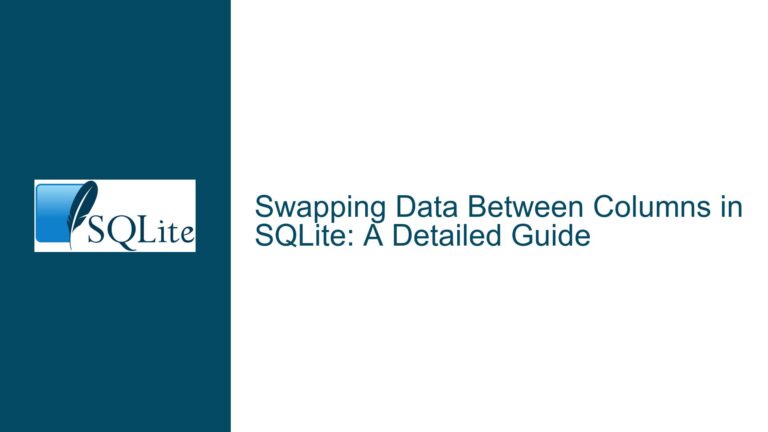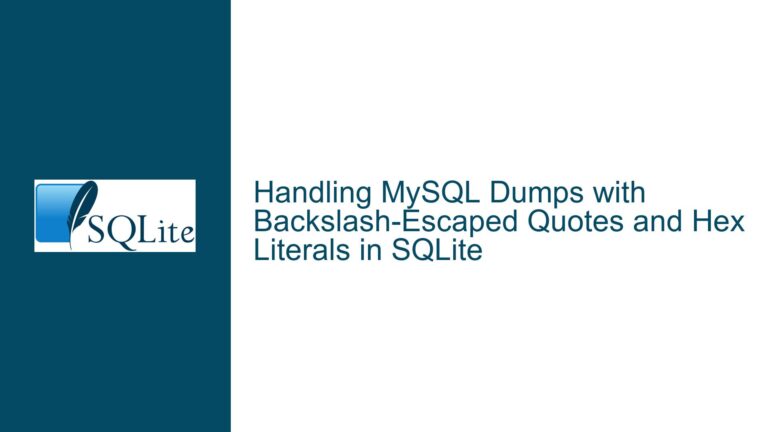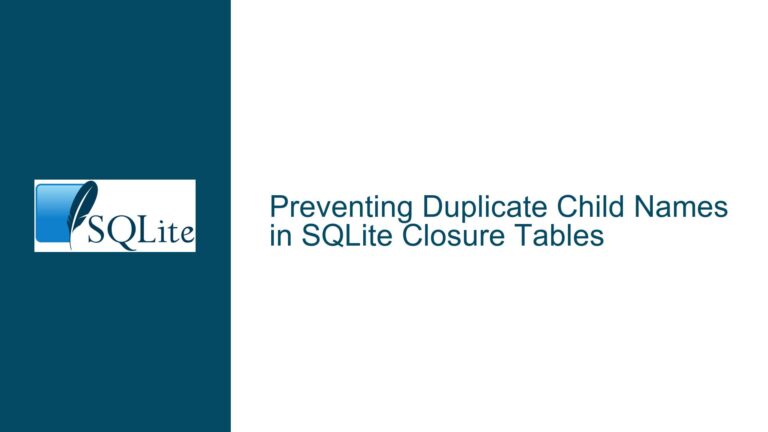Removing Trailing HTML Line Breaks in SQLite Without Affecting Internal Tags
Understanding the Challenge of Trimming Specific Trailing Substrings in SQLite
The core problem revolves around manipulating text fields containing HTML markup where a specific closing sequence (<br />) must be removed only when it appears as the very last characters in the field. This requires precise substring operations to avoid damaging legitimate <br /> tags appearing elsewhere in the content. A typical example from scriptural text databases demonstrates the complexity: fields contain multiple HTML line breaks for formatting, but an erroneous trailing <br /> needs elimination. The challenge intensifies when dealing with thousands of records requiring batch processing without manual inspection.
SQLite’s string manipulation functions operate at the character level rather than treating multi-character patterns as atomic units. This creates inherent risks when attempting to remove fixed-length substrings from variable-length fields. The primary danger lies in miscomputing substring positions – a mistake that could truncate valid content or leave residual characters from the target substring. For instance, removing 6 characters (<br />) requires knowing the exact position of their occurrence at the string’s end, but miscalculating the starting index by even one character would corrupt adjacent content.
Common Pitfalls When Attempting to Remove Fixed Trailing Substrings
Misapplication of RTRIM/LTRIM Semantics
A critical misunderstanding arises from assuming RTRIM() removes trailing substrings. In reality, its second argument specifies a set of characters to remove, not a sequence. If a field ends with <br />, using RTRIM(field, '<br />') will strip all individual characters ‘b’, ‘r’, ‘/’, ‘>’, and ‘<‘ from the end until none remain – potentially deleting much more than intended. This behavior explains why RTRIM('...brrr<br />', '<br />') reduces the string to '...' – it keeps removing ‘b’, ‘r’, etc., until hitting characters not in the trim set.
Off-By-One Errors in Substring Indexing
The SUBSTR() function’s syntax (SUBSTR(string, start, length)) demands precise arithmetic when calculating positions from the string end. Initial attempts using LENGTH(field) - LENGTH('<br />') may still fail due to:
- Forgetting that substring length counts from position 1
- Not accounting for zero-based vs one-based indexing
- Overlooking trailing whitespace altering effective string length
For example, SUBSTR(ln, 1, LENGTH(ln) - 7) assumes <br /> is exactly 6 characters (correct), but subtracting 7 would erroneously remove an extra character. This stems from confusing the third argument of SUBSTR() (desired result length) with the ending position index.
Failure to Handle Variable Trailing Whitespace
Real-world data often contains irregular whitespace before the target substring. A field ending with ' <br />' (three spaces followed by <br />) would not match a simple LIKE '%<br />' condition. Even if detected, using fixed-length trimming would leave the spaces intact while removing part of the HTML tag. This necessitates combining RTRIM() for whitespace cleanup with substring removal.
Step-by-Step Methods to Safely Remove Trailing HTML Line Breaks
Precision Trimming with SUBSTR and LIKE Conditions
Identify Affected Records
Filter rows where the field ends with<br />using case-sensitive pattern matching:SELECT * FROM Bible WHERE Scripture LIKE '%<br />' AND Scripture NOT LIKE '%<br /> %'; -- Exclude cases with trailing contentFor databases with case variations (e.g.,
<BR />), useLIKEwith wildcards carefully or applyCOLLATE NOCASE.Calculate Substring Boundaries
UseLENGTH()to determine exact trim points:UPDATE Bible SET Scripture = SUBSTR(Scripture, 1, LENGTH(Scripture) - 6) WHERE Scripture LIKE '%<br />' AND SUBSTR(Scripture, -6) = '<br />';The
SUBSTR(Scripture, -6)extracts the last 6 characters for exact match verification, avoiding false positives from earlier<br />occurrences.Handle Optional Trailing Whitespace
CombineRTRIM()and nestedSUBSTR()to manage spaces:UPDATE Bible SET Scripture = RTRIM( SUBSTR(Scripture, 1, LENGTH(Scripture) - 6), ' ') WHERE Scripture LIKE '%<br />' AND SUBSTR(RTRIM(Scripture), -6) = '<br />';This trims spaces after removing
<br />, preserving intentional whitespace elsewhere.
Robust Update Query with Safety Guards
For production use, implement a transaction with pre/post validation:
BEGIN TRANSACTION;
-- Backup affected records
CREATE TEMP TABLE ScriptureBackup AS
SELECT rowid, Scripture FROM Bible
WHERE Scripture LIKE '%<br />';
-- Perform update with length check
UPDATE Bible
SET Scripture = SUBSTR(Scripture, 1, LENGTH(Scripture) - 6)
WHERE rowid IN (SELECT rowid FROM ScriptureBackup)
AND LENGTH(Scripture) >= 6
AND SUBSTR(Scripture, -6) = '<br />';
-- Verify count matches expected changes
SELECT COUNT(*) FROM Bible
WHERE rowid IN (SELECT rowid FROM ScriptureBackup)
AND SUBSTR(Scripture, -6) <> '<br />';
COMMIT;
Advanced HTML-Aware Processing Using Tcl and tDOM
For complex HTML manipulation exceeding SQLite’s string functions:
Enable Tcl Extension in SQLite
Load the Tcl extension to access HTML DOM parsing:.load /usr/lib/tcltk/sqlite3/libtclsqlite3.soCreate Tcl Procedure to Sanitize Trailing BR Tags
proc sanitize_scripture {scripture} { set doc [dom parse -html $scripture] set root [$doc documentElement] set nodes [$root selectNodes "//text()"] set lastTextNode [lindex $nodes end] if {[string trim [$lastTextNode nodeValue]] eq ""} { set parent [$lastTextNode parentNode] $parent removeChild $lastTextNode } return [$doc asHTML] }Integrate with SQLite Using User-Defined Functions
Register the Tcl procedure as a SQL function:SELECT load_extension('libtclsqlite3.so'); CREATE FUNCTION sanitize_scripture(text) RETURNS text AS $$ return [sanitize_scripture $1] $$ LANGUAGE tcl; UPDATE Bible SET Scripture = sanitize_scripture(Scripture);
This approach parses the HTML structure, identifies trailing empty text nodes following <br /> tags, and removes them without affecting semantic content. It handles nested HTML elements and preserves original formatting while surgically removing only the specified trailing break tags.
Validation and Rollback Strategies
Implement MD5 checksum verification before/after updates to detect unintended changes:
ATTACH DATABASE 'backup.db' AS backup;
-- Generate checksums
CREATE TEMP TABLE original_checksums AS
SELECT rowid, md5(Scripture) AS hash FROM Bible;
-- Perform update operations...
-- Verify integrity
SELECT COUNT(*) FROM Bible
WHERE rowid IN (SELECT rowid FROM original_checksums)
AND md5(Scripture) <> (SELECT hash FROM original_checksums
WHERE rowid = Bible.rowid);
-- Rollback if discrepancies exceed expected changes
For large datasets, optimize performance by:
- Creating indexes on length-prefixed columns
- Batching updates in 1000-row chunks
- Disabling journaling during mass updates with
PRAGMA journal_mode = OFF
Mitigating Encoding and Collation Issues
Character encoding mismatches can cause substring operations to fail. Ensure consistent UTF-8 handling:
PRAGMA encoding = 'UTF-8';
UPDATE Bible
SET Scripture = SUBSTR(Scripture, 1, LENGTH(Scripture) - 6)
WHERE CAST(Scripture AS BLOB) LIKE CAST('%<br />' AS BLOB);
This forces binary comparison, avoiding locale-specific collation rules that might ignore case or accent differences.






